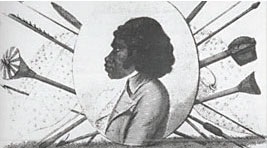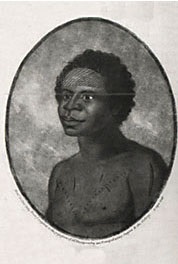Aboriginal History
Wallumedegal
Aboriginal people lived for thousands of years in what we call the City of Ryde. When the first Europeans settled at Sydney Cove in 1788 the traditional owners of this area were the Wallumedegal. That name was told to Captain Arthur Phillip, first governor of the convict colony of New South Wales, by Woollarawarre Bennelong who came from the clan called the Wangal on the south side of the river.
It is likely that the name Wallumedegal or Wallumattagal was derived from wallumai the snapper fish, combined with matta, a word used to describe a place, usually a water place, as with Parramatta and Cabramatta. That would mean they were the snapper clan and the fish was their totem, just as burra (the eel) was the totem of the Burramatta or Boromeda-gal or clan at Parramatta and cobra (the white grub of the shipworm) that of the Cobragal at present Liverpool and Cabramatta.
Wallumedegal territory followed the north bank of the Parramatta River from Turrumburra (Lane Cove River) in the east to Burramatta at the head of the river to the west. The northern boundary would logically be the Lane Cove River and the northern neighbours therefore the Cameragal or spear clan. Further east, opposite the Cameragal, were the Cadigal, a harbour-dwelling clan, which occupied the present Eastern Suburbs and City of Sydney, from Inner South Head to Darling Harbour.

Bennelong with armorial bearings published in 1798
The Wallumedegal survived for generations in a rich environment of river flats, creeks and mangrove swamps, fishing with pronged spears and handlines, feasting on shellfish, hunting birds and small game, and collecting a variety of edible bushfood plants. They spoke the same language as the Port Jackson and coastal clans, from Botany Bay to Broken Bay. The dialect of the sea coast, wrote Marine Captain Watkin Tench, was spoken at Rose Hill (Parramatta). The dialect of the same language west of Parramatta is now called Darug.
The first encounters between the foreigners in boats and the river people in February 1788 were friendly, with laughter and mimicry on both sides. Their lives changed forever the following November when armed marines built an earthwork fort at Parramatta.
Dispossession
This action displaced the family of the Burramattagal elder Maugoran and his wife Gooroobera, who were forced to move down the river to The Flats, near Meadowbank. Then in April 1789 came the smallpox epidemic, which Bennelong said killed half the Indigenous population. Smallpox might account for the fact that no Wallumedegal are identified in history, unless, which is possible, either or both of Maugoran's wives, Gooroobera or Bidgee Bidgee - mother Tadyera who died of dysentery, were Wallumedegalleon (wallumedagaliang), or women belonging to the clan.
Significant Aboriginal People of Ryde
The most enduring symbol of the Aboriginal presence in the City of Ryde is the grave of Bennelong and Nanbarry, two key figures in the history of early Sydney.

Bidgee Bidgee 1803
Bennelong, who was captured late in 1789 on the orders of Governor Arthur Phillip, escaped after six months. In October 1790, one month after Phillip was speared at Manly Cove, Bennelong came in peacefully to the settlement at Sydney. Phillip built him a brick hut at Tubowgulye, now Bennelong Point, and took him to England two years later.
Bennelong died in 1813 and was buried in the orchard of brewer James Squire at Kissing Point (Ryde) where he had lived for some time. When Nanbarry, nephew of Colebee the Cadigal elder, died in August 1821 he was buried at his request with Bennelong and his last wife, who might have been Boorong, sister of Bidgee Bidgee. They lie together somewhere overlooking the river close to Bennelong Park.
For twenty years the most prominent leader in this district was Maugoran's youngest son, Bidgee Bidgee, made chief of Kissing Point in 1816 by Governor Lachlan Macquarie, who also gave him a brass breastplate and a fishing boat. Bidgee Bidgee meant a river flat.
Bennelong, Nanbarry and Bidgee Bidgee went on long sea voyages in English sailing ships, but they spent their last years at Kissing Point. Bundle, was another key figure in the area who tracked robbers for Squire in 1804 when he was district constable. Bundle joined the crew of ships commanded by Captain Philip Parker King. He was the Old Bundle who held Bennelong's son Dicky, baptised as Thomas Walker Coke, in his arms the day he died aged nineteen in 1823.
History records that Bidgee Bidgee and a few other Kissing Point Aborigines received blankets at Parramatta in 1834 and 1836. At this time it seems that Samuel Marsden was probably referring to Bidgee Bidgee (who seems to have died in 1837) when he wrote that:
"..from Sydney to Parramatta all along the north side of the river, there is but one original Native, the rest are all dead; thou they were very numerous in these districts."
This section is an abstract from the paper, Wallumedegal : An Aboriginal History of Ryde, written by Keith Vincent Smith who was recommended by the Warawara Department of Indigenous Studies at Macquarie University. Since 1993 he has established a track record as a researcher and author of Aboriginal history and anthropology.